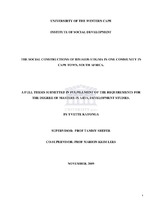| dc.description.abstract | Due to tremendous stigma attached to HIV/AIDS, revelation of HIV positive sero-status of an individual has become a significant risk in communities of South Africa (Kalichman el al., 2003;Deacon et al., 2004; Kalichman et al., 2005, Simbayi et al., 2007). Several researchers have argued that HIV/AIDS stigma poses severe problems which include that it delays HIV testing;stops people living with HIV and AIDS (PLWHA) from seeking care; inhibits incorporation of prevention behaviours; increases violence against HIV-positive people; and extends beyond PLWHA to families, providers and volunteers. HIV/AIDS stigma is widespread, and it is widely
accepted that it does not only reflect but also is exacerbated by co-existing stigmas related to poverty, race, gender, substance use, and sexual behaviour (Parker et al., 2002; Parker & Aggleton, 2003; Holloway, Seaton, Taylor, 2004).This study aimed to understand whether HIV/AIDS as a social construct and those living with
HIV/AIDS are understood and responded to differently by males and females and those previously classified by the apartheid divisive policy as African and Coloured participants in the context of their daily encounters. Hence, the study investigated whether there is a relationship between race, gender and HIV/AIDS stigma among participants and whether this relationship is mediated by age, educational level, and participants’ household situation. In addition, the study explored whether gendered stigmatization is subscribed to by participants, while it further sought
to assess the extent to which participants were exposed to HIV and AIDS; and whether there were gender and racial differences with respect to participants’ perceptions about PLWHA.Finally, the study scrutinized participants’ perceived levels where they believe interventions to eliminate stigma could be prioritized.
This study utilized a survey questionnaire drawn up on the basis of qualitative findings in earlier studies on stigma and HIV/AIDS in both ‘African’ and ‘coloured’ communities. Two hundred participants were recruited through a convenience sampling method in the Mitchell’s Plain area of Cape Town, South Africa. The sample was stratified by ‘race’ and gender with the majority between the age of 35 and 49 years; 50.3 % of the respondents in the sample were males, while 49.7 % were females. The majority of the respondents were Africans of Xhosa speaking descent(49.2 %) and coloureds (48.2 %) with a small proportion of whites (2.5 %). All standard ethical procedures for research with human participants were adhered to and the project was registered with the UWC Research & Ethics Committee. All participants responded on the basis of informed consent and consent forms were signed to confirm ethical assurances. Confidentiality of the data was observed and the data was kept in a locked up and secure place for a period of five years after the study. Completed survey questionnaires were coded, and analyzed quantitatively using the Statistical Package for Social Sciences version 17.0 (SPSS) and SAS.Inferential statistics showed highly significant gender differences in participants’ personal stigmatization. More so, personal stigma attitudes were more likely to be found among older males and with means to support their households. Descriptive results showed these older males were less likely to know someone with HIV. The study acknowledged that HIV and AIDS as well as PLWHA are socially constructed and intersected with existing social inequalities on difference and hence, recommends that interventions to address HIV/AIDS stigma need to take cognizance of the contexts in which it occurs. It seems important to address de-stigmatization efforts at coloured families since descriptive results reflect some denial that HIV is a challenge and/or that PLWHA are stigmatized in families and community at large. Gendered constructions of stigma, while impacting on both men and women (since both appear to be stigmatized differently), are clearly still salient and it is recommended that efforts be continually made to raise the way in which gender, class, racialised and other differences of power are being played
in community responses to HIV and those living with HIV/AIDS. | en_US |

